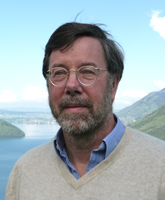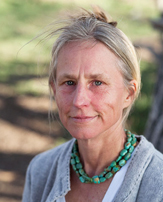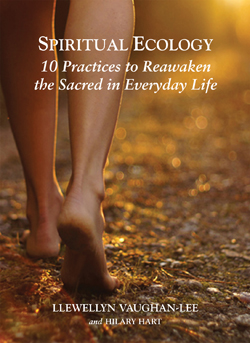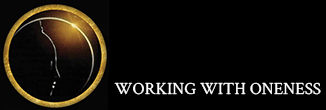Book: Spiritual Ecology: 10 Practices to Reawaken the Sacred in Everyday Life
New Spring 2017
Spiritual Ecology: 10 Practices to Reawaken the Sacred in Everyday Life
by Llewellyn Vaughan-Lee and Hilary Hart
“This small book, exquisite in its luminous simplicity, brings me home to my life. Even in a dark time, its practices center me in a sense of the sacred, our birthright.”
—JOANNA MACY, teacher, activist, and author of Coming Back to Life: The Updated Guide to the Work That Reconnects
“Llewellyn Vaughan-Lee’s book on practices for Spiritual Ecology in everyday life awakens us to the potential to take small steps towards big transformation. It overcomes the artificial divide between nature and humans, and spirituality and action. No matter who we are, where we live, these are steps each of us can take.”
—VANDANA SHIVA, activist and author
“A beautiful book. Llewellyn Vaughan-Lee and Hilary Hart do a brilliant job sharing simple and powerful practices that help readers connect to the sacredness within nature, the earth, and our own daily lives.”
—SANDRA INGERMAN, author, Walking in Light:
The Everyday Empowerment of Shamanic Life
Spiritual Ecology: 10 Practices to Reawaken the Sacred in Everyday Life offers inspiring and practical guidance for reconnecting to the sacred in every day life and transforming our relationship with the Earth. Describing the power of simple, daily practices such as Walking, Gardening, Cooking with Love, and Prayer, this small book supports profound changes in how we think about and respond to the ecological crisis of our times.
Our groundbreaking book, Spiritual Ecology: The Cry of the Earth, (now in its second edition)—which included spiritual perspectives on climate change, species loss, deforestation, and other aspects of our present environmental crises from renowned spiritual teachers, scientists, and indigenous leaders—drew an overwhelmingly positive reaction from readers, many of whom are asking: “What can I do?”
Spiritual Ecology: 10 Practices to Reawaken the Sacred in Everyday Life answers that question with inspiring, personal anecdotes from the author—Sufi teacher Llewellyn Vaughan-Lee—and simple practices we all can do. Rooted in the mystical foundation of the world’s great spiritual traditions, with a particular connection to Sufism, these timeless practices remind readers of our deep connections to life, each other, and the Earth, and invite a return of meaning to our desecrated world.
As Rumi says, “there are a thousand ways to kneel and kiss the ground,” and it is this sacred ground that is calling to us, that needs our living presence, our attentiveness. This small book offers simple ways to reconnect so that we can once again feel the music, the song of our living connection with the Earth.
| Advance orders are available from the US. For those in the UK, the book will be available from mid-to-late April, and for those in Europe, starting at the late April Retreat in Emmetten, Switzerland, and thereafter. | |
| Paperback: $12.95 eBook Download: $9.99 112 pages · 5.25 x 7.25 · ISBN: 9781941394182 Pub date: May 1, 2017 |
|
|
|
|
About the Authors
 Llewellyn Vaughan-Lee, Ph.D., was born in London in 1953 and has followed the Sufi path since he was nineteen. In 1991 he moved with his family to Northern California and founded The Golden Sufi Center. Author of several books, he has specialized in the area of dreamwork, integrating the ancient Sufi approach to dreams with the insights of modern psychology. Since 2000 the focus of his writing and teaching has been on spiritual responsibility in our present time of transition, and an awakening global consciousness of oneness. More recently he has written about the feminine, the Anima Mundi (world soul), and spiritual ecology (www.workingwithoneness.org). He has been interviewed by Oprah Winfrey on Super Soul Sunday, and featured on the Global Spirit series shown on PBS.
Llewellyn Vaughan-Lee, Ph.D., was born in London in 1953 and has followed the Sufi path since he was nineteen. In 1991 he moved with his family to Northern California and founded The Golden Sufi Center. Author of several books, he has specialized in the area of dreamwork, integrating the ancient Sufi approach to dreams with the insights of modern psychology. Since 2000 the focus of his writing and teaching has been on spiritual responsibility in our present time of transition, and an awakening global consciousness of oneness. More recently he has written about the feminine, the Anima Mundi (world soul), and spiritual ecology (www.workingwithoneness.org). He has been interviewed by Oprah Winfrey on Super Soul Sunday, and featured on the Global Spirit series shown on PBS.
 Hilary Hart is the author of three books about mysticism with a focus on women and feminine consciousness. She has been on the Sufi path since 1998. Originally from New England, Hilary currently lives in Taos, New Mexico. Her previous books include Body of Wisdom: Women’s Spiritual Power and How It Serves and The Unknown She: Eight Faces of an Emerging Consciousness. Further information:www.hilaryhart.org
Hilary Hart is the author of three books about mysticism with a focus on women and feminine consciousness. She has been on the Sufi path since 1998. Originally from New England, Hilary currently lives in Taos, New Mexico. Her previous books include Body of Wisdom: Women’s Spiritual Power and How It Serves and The Unknown She: Eight Faces of an Emerging Consciousness. Further information:www.hilaryhart.org
Press
May 3, 2017, New Article: Tablet Magazine has also just published an excerpt, “Clean Your Room: Our spiritual ecology is messed up. Time to put things in order.”
May 1, 2017, New Article: Parabola has just published an excerpt from Chapter 6, The Art of Cleaning.

Excerpts
Ch 1—Walking:
This is a practice that has been with me since my teens—when I first started to meditate I also needed to walk. It was not taught or learned, but came as a need, a way to be, an antidote to much of the world around me—a world of people and problems, demands and desires. When one foot follows the other and the day has hardly begun, it seems these demands cannot touch me, as if I am immersed in something simpler, more essential. Placing each foot on the earth is a practice, but a practice that comes from my own roots, not a book or a teacher. Later I came to hear it called ‘walking in a sacred manner,’ and it is sacred, a return to what is sacred. But it also is deeper or more primal thanany purpose. Nature speaks to me and I listen. Nature calls and something deep within me responds, and I just need to give it space. I am part of a life far greater than any ‘me.’(p. 2)
Ch 2—Breathing:
While we are alive, with each cycle of the breath the soul makes its journey into this world and then back to the Source. Spiritually we aspire to make this journey conscious. It is the lived prayer of the soul, an offering of our self to the mystery of life and its all-embracing relationship to the Divine. With each breath we consciously connect the two worlds, the world of the spirit and the physical world. We are present in the love affair that is the relationship between the Creator and the creation. (p. 10)
Ch 3—Gardening:
Recently I have loved to grow potatoes. I made two new beds for my potatoes, dug and composted, and planted my seed potatoes, and then waited. As I said, I am not a natural gardener, not naturally in tune with the rhythms of the Earth. This has been a gift that life has unexpectedly offered to me—this simple joy in waiting, watching the shoots begin to come from the soil, and then finally putting my fingers in the soil to dig up my potatoes, feeling the wonder of so many potatoes from a single seed. Of course these are not the perfect potatoes bought from the store. These are my own potatoes, cherished because I planted them, and their imperfections do not bother me. I love their taste, sweet and buttery. In my potatoes the Earth has given me more than abundance and nourishment; it has also brought this joy I had never expected—a simple primal joy that is a remembrance of life. (p. 21)
Ch 4—Seeds and Their Stories:
What I experience in my small garden is part of a story that has held us for millennia. It has given life meaning and sustenance. But today we are losing both our seeds and their stories. The biodiversity that was central to life for thousands of years is being lost. We are becoming a monoculture with a scarcity of seeds, a scarcity so severe that people have even created seed banks in the frozen North to protect our heritage of seed diversity. (p. 27-28)
Ch 5—Cooking with Love:
Through being attentive to the preparation of our food we bring an awareness into a basic substance and sustenance of life. Just as being aware of the breath is central to spiritual life, reconnecting us with life’s essence, so is the simple art of cooking. What is more satisfying than a bowl of rice and vegetables that you have prepared and cooked with attention—what is a greater gift to a visitor and friend? (p. 38)
Ch 6—Cleaning:
There is a simple spiritual practice that is often overlooked—the art of cleaning. The image of the monk sweeping the courtyard has a deep significance, because without the practice of cleaning there can be no empty space, no space for a deep communion with the sacred. Outer and inner cleaning belong to the foundation of spiritual practice, and as the monk’s broom touches the ground, it has a particular relationship to the Earth. We need to create a sacred space in order to live in relationship to the sacred within ourselves and within creation. (p. 47)
Ch 7—Simplicity:
How can we create a space of clarity, of attentiveness? How can we return to what is essential? How can we remember what really matters, what gives meaning and substance to our daily lives? How can we return to a simplicity of life that honors the simplicity of our essential nature, that gives space for the sacred? (p. 58)
Ch 8—Prayer:
Watching, listening, we develop the ear of the heart, the eye of the heart, the inner receptivity of the soul. And if we can listen to the Beloved within creation, to the miracle of the Earth in all Her forms, we will hear the Beloved speak to us as She spoke to our ancestors. We will find ourself in a world as whole as it is holy. (p. 69)
Ch 9—Death:
Nature does not need a facelift. She is eternally young because she is always dying. She is the hundred-year-old tree falling in a thunderstorm as well as the first shoots of spring. The Japanese understood this quality of the sacred, building their temples in wood and not stone so that they would have to be rebuilt again and again. (p. 78)
Ch 10—Meaning and the Sacred:
When our ancestors knew that everything they could see was sacred, this was not something taught but instinctively known. It was as natural as sunlight, as necessary as breathing, a fundamental recognition of the wonder, beauty, and divine nature of the world. From this sense of the sacred real meaning is born, the meaning that makes our hearts sing with the deepest purpose of being alive.
Tragically, our present culture appears to have lost sight of this vital quality. Instead we live on the surface, separated from the real substance that has always given everyday life a depth of meaning. We are told to find meaning in our individual life, but all around us life itself tells us a different story—that we are part of the Earth, that we belong to the community of all of life in its myriad forms. Only through recognizing and living this sacred unity can we find and experience the real meaning that life is offering to us. And so we have to find ways to remember, to reconnect, to feel again what is all around us. (p. 88)
